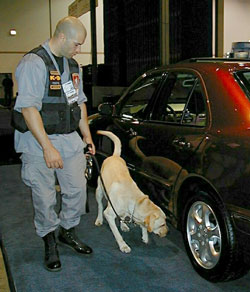Small Spheres Make a Big Signal

Imagine a device that intensifies light a million times by focusing it down to a point the size of a few dozen atoms. In the 28 November PRL, a team proposes using a series of three nano-sized metal balls as a “nanolens” to gather and focus light. If it can be made practical, the nanolens could help identify minute chemical samples, produce bright nanoscale light sources, or even create a new type of laserlike device called a SPASER.
When light shines on an unknown material, the spectrum of scattered light can give a unique “fingerprint” that identifies the sample. This technique, called Raman spectroscopy, would be ideal for sniffing out tiny quantities of drugs or explosives in airports, if the signal weren’t so weak, says Mark Stockman, of Georgia State University in Atlanta. Some Raman researchers have used colloidal silver emulsion–better known for its role in developing black and white photographs–to enhance the Raman signals from single molecules. But it wasn’t clear exactly how clusters of silver atoms floating in a liquid or stuck to a surface can amplify Raman signals. Stockman and his colleagues set out to understand colloidal silver at the microscopic level and propose a tool that might allow the Raman technique to be used outside physics labs.
The clusters in colloidal silver have a wide range of sizes, and they hook up to form complex loops and patterns. The team suspected that this structure was somehow focusing the incoming light into a small space that allowed more light to illuminate a single molecule and less to be wasted.
They designed a simple model of three successively smaller nanospheres in a row, ranging in diameter from 50 to 5 nanometers. According to their calculations, when light shines on the largest sphere, it sets up a surface plasmon–a wave of vibrating electrons on the surface of the sphere–that creates an oscillating electric field. This field transmits the energy down to the medium-sized sphere, which in turn passes it to the smallest sphere in the same way. The end result is an oscillating electric field containing much of the original light energy but concentrated to a point located between the smallest and next-to-smallest nanospheres. The concentration leads to a million-fold increase in intensity.
Stockman emphasizes that the model is merely a guess at the mechanism by which the Raman signal is enhanced. “Like a plane is not the same as a bird, the nanolens is not a copy of colloidal silver, but another way of doing the same,” he says. Raman scattering is just one technique that probes tiny objects with light. Stockman has also proposed that surface plasmons could be focused in a laser like device called a SPASER (surface plasmon amplification by stimulated emission of radiation). Victor Klimov of the Los Alamos National Laboratory in New Mexico says the research shows that chains of spheres can be engineered to produce a “dramatic enhancement in the applied electric field.” He adds that the spatial position of the focal point should be controllable with nanoscale precision.
–Kim Krieger
Kim Krieger is a freelance science writer in Norwalk, Connecticut.


